 print preview
print previewback ASHLEY KISTLER
Hope Wall RVA, 2020–21
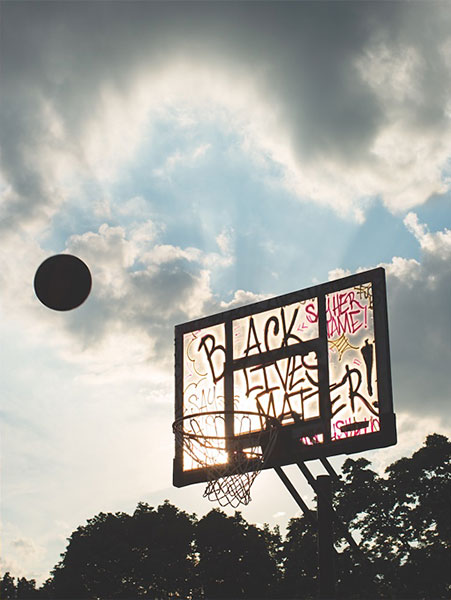 |
| Richmond-based journalist Brian Palmer’s poster design, included in Round 1. |
Rob Carter, John Malinoski, and I launched the Hope Wall in early September 2020, soon after the Black Lives Matter protests on nearby Monument Avenue, and during the pandemic’s seemingly unstoppable momentum. It was a time of celebration and desperation, as we witnessed the genesis of Richmond’s long-overdue racial reckoning, as well as the unimaginable toll on human lives wreaked by COVID-19. Once initiated, we decided to continue this temporary public art project for one year.
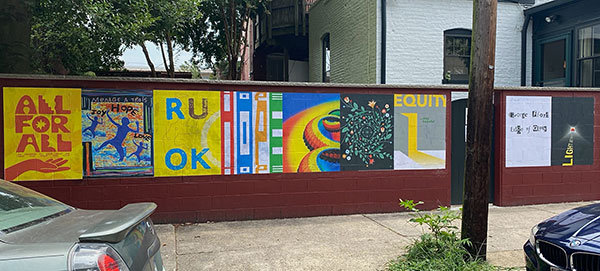 |
| Round 16, July 2021 |
The theme of hope first became an impetus for a possible temporary installation in the aftermath of the 2016 presidential election. In the context of recent events, it gained added urgency, prompting us to undertake a more ambitious project whereby we would solicit responses from designers and artists near and far. Our intent was to explore a multitude of ideas and perspectives on this theme as a way of stimulating conversation about the many critical issues that confront us.
These responses took the form of three-by-four-foot posters, wheat pasted on a thirty-foot-long block wall in the Fan District, only a few blocks from Monument Avenue. This public “canvas,” comprising nine posters in each of eighteen rounds, changed every three weeks as new posters were added on top of existing ones. National and international designers, representing twenty countries, along with a strong Richmond contingent participated; they included young designers as well as long-established figures in the field. Rob and John, both veteran graphic designers and now-retired professors who helped shape the VCU Department of Graphic Design during its formative years, invited submissions from a number of their former VCU students, who are now accomplished, geographically dispersed professionals.
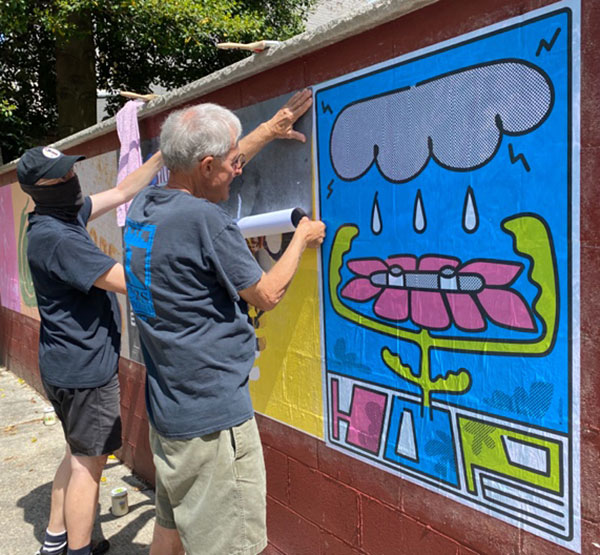 |
| Rob Carter and John Malinoski at work, April 2021. |
The medium, location, and temporary nature of the project were inspired by the history of wheat pasting posters in the urban landscape, long used as an effective grassroots form of visual communication, particularly during turbulent periods. This DIY medium once again seemed especially appropriate for our times. Inexpensive posters were printed locally from digital files provided by participants; every three weeks, John cooked up nine jars of wheat paste in his kitchen. “Reuniting with and meeting designers through the internet was efficient, surprising, and gratifying,” he comments. “I looked at many, many posters; opening an attached poster file was always exciting. Making and brushing paste to install each one was simple and fundamental—an uncomplicated and refreshing means to project a message during upside-down days. The experience reminded me of the effectiveness of constraints and simple things.” The entire project was self-funded.
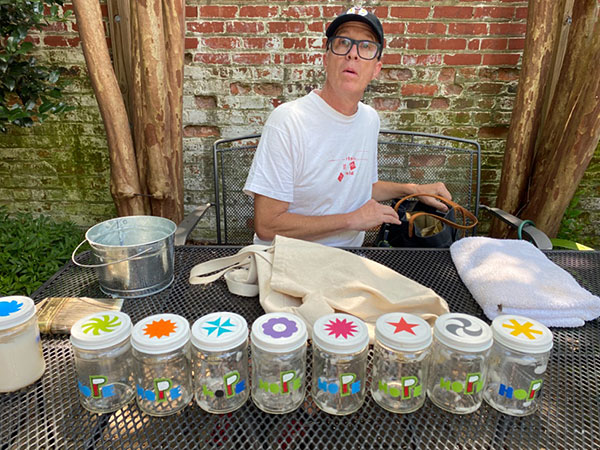 |
| John Malinoski with his wheat-paste jars. |
The more than 160 poster designs making up the project spanned a remarkable interpretive range—by turns joyous, wishful, poetic, political, forceful, heartening, playful, resolute, and even dispirited. They probed the many facets of this shared and passionate, if occasionally wavering, conviction in the face of formidable challenges—local and global—and most often reflected a full-throated desire for growth and unity. We thank each of these artists for contributing to an exceptionally resonant and provocative conversation, which, over an unprecedented year of both turmoil and promise, sustained us and, we hope, many others.
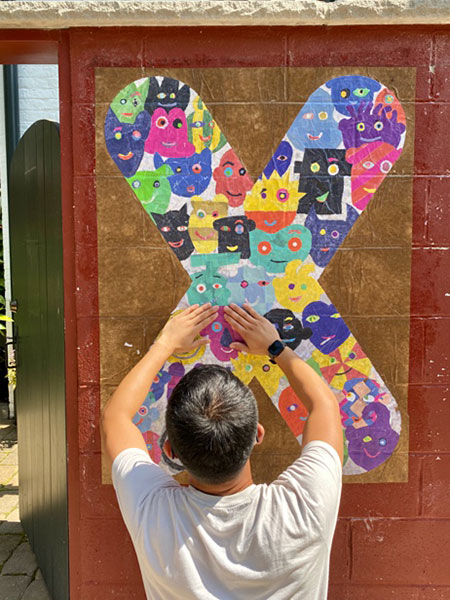 |
| Designer An Liu, aka Sledge, helping with the final installation. |
On September 5, 2021, we concluded the project with this message—CONNECT XO—which on many levels not only encapsulates our experience of this process, but also serves as a necessary prelude to achieving understanding and respect—essential steps toward realizing an equitable and inclusive future. John and Rob rendered this hopeful appeal by recycling the salvaged scraps of posters from the previous seventeen rounds. In a spirit of trust and solidarity, they divided up these letters in an alternating sequence—splitting the ninth letter in half—not knowing until their installation what each other had created.
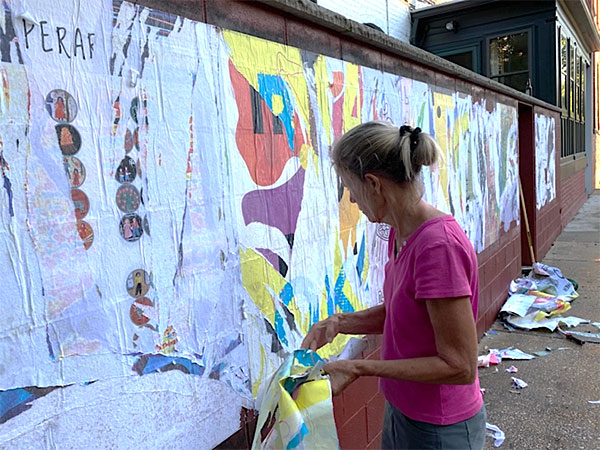 |
| Ashley Kistler preparing the wall for the final round. |
“Now that the last round of posters has been pasted to the wall and I watch them age and fade and peel,” Rob observes, “I’m reminded that the beauty of wheat pasting in an outdoor environment lies in the ephemeral nature of the paste, and that nothing about the process is precise. The Hope Wall was a living organism; as new posters were added and earlier posters peeled away, messages of hope were lodged in hearts and minds over time.”
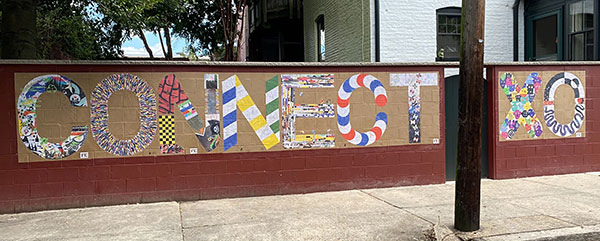 |
| Rob Carter and John Malinoski, Hope Wall finale, September 5, 2021. |
![]()
A book documenting the Hope Wall will be available in 2022. Special thanks to Erin and Brian Palmer whose photo documentation of the project will appear in our book.
Rob Carter is the author of American Typography Today (Van Nostrand Reinhold, 1988), the five-volume series Working with Type (Watson-Guptill Publications, 1998), Digital Color and Type (Rotovision, 2002), and Meggs: Making Graphic Design History (Wiley, 2007), and the co-author, with Philip B. Meggs, of Typographic Design: Form and Communication (seven editions) and Typographic Specimens: The Great Typefaces (both Wiley, 1993). With John Bryan, he co-authored the landmark book America’s Favorite Flies (Charles Creek Publishing, 2017). He is an independent designer and artist in Richmond.
John Malinoski practices graphic design in Richmond through his studio, Somehow Something, focusing on community-based, collaborative, and self-initiated projects. His work has been exhibited, presented, published, and received awards nationally and internationally. He taught for many years in the Department of Graphic Design at Virginia Commonwealth University where he coordinated the department’s MFA program and was a founder of the experimental, interdisciplinary mOb studio in downtown Richmond.
Hope Wall RVA, 2020–21
Hope Wall Slide Show